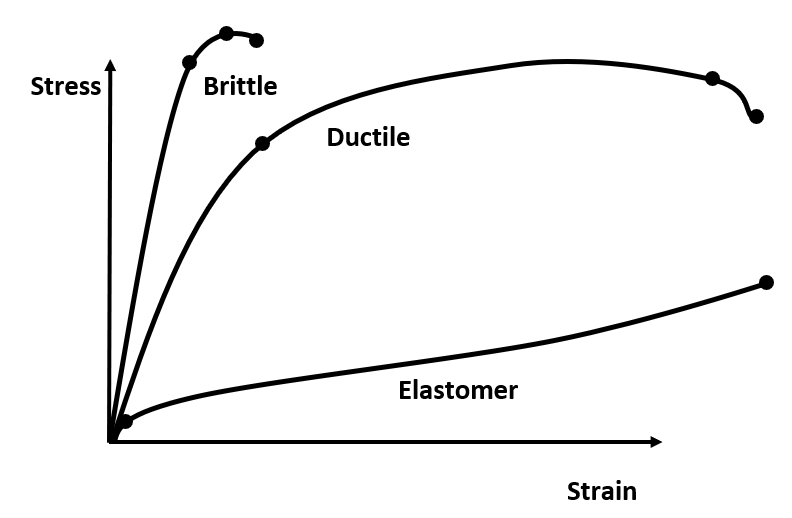
Explain with examples, ductile materials, brittle materials and elastomers on the basis of stress-strain curves.
Answer
516.9k+ views
Hint: Let us first understand a stress-strain curve for a solid. This curve basically gives the relationship between stress and strain with strain along the X-axis and stress along the Y-axis. This curve is obtained by gradually applying force (load) on the material and seeing its characteristic stress and strain values.
Complete answer:
Let us first draw the stress-strain curves for all the different materials and then understand them with the help of some examples.
The stress-strain curve is shown below:

In the above curve, we can see that the stress-strain curve is a straight line for a certain measure of load for brittle materials and ductile materials. This is the region up to which Young’s Law is valid.
Now, if we see the curve of a brittle material, it breaks off soon after reaching the point of maximum load. This means brittle materials break-off in pieces after applying a substantially large force on them. The example of brittle materials are, Cast iron, brick, concrete, etc.
In the case of a ductile material, even if we exceed the point of Yield stress, the point after which there is permanent deformation, the material still survives large values of force until it breaks off. This means ductile materials, on being applied by large forces, tend to convert into thin wire before breaking off. For example, Copper, Silver, Gold, etc.
Now, elastomers do not obey Young’s law even at low stress. That means they tend to deform even at very low load values. But they have a significantly high break-off point which causes large deformation in them but they do not break off. For example, Natural rubber, Ethylene propylene rubber, etc.
Note:
Apart from these three types of materials, there is one other very common material type that is called malleable materials. This type of material has a very high breaking point like ductile materials but on beating them with a hammer (applying large force), they tend to convert into sheets. Their common examples can be, Aluminum, Lead, etc.
Complete answer:
Let us first draw the stress-strain curves for all the different materials and then understand them with the help of some examples.
The stress-strain curve is shown below:

In the above curve, we can see that the stress-strain curve is a straight line for a certain measure of load for brittle materials and ductile materials. This is the region up to which Young’s Law is valid.
Now, if we see the curve of a brittle material, it breaks off soon after reaching the point of maximum load. This means brittle materials break-off in pieces after applying a substantially large force on them. The example of brittle materials are, Cast iron, brick, concrete, etc.
In the case of a ductile material, even if we exceed the point of Yield stress, the point after which there is permanent deformation, the material still survives large values of force until it breaks off. This means ductile materials, on being applied by large forces, tend to convert into thin wire before breaking off. For example, Copper, Silver, Gold, etc.
Now, elastomers do not obey Young’s law even at low stress. That means they tend to deform even at very low load values. But they have a significantly high break-off point which causes large deformation in them but they do not break off. For example, Natural rubber, Ethylene propylene rubber, etc.
Note:
Apart from these three types of materials, there is one other very common material type that is called malleable materials. This type of material has a very high breaking point like ductile materials but on beating them with a hammer (applying large force), they tend to convert into sheets. Their common examples can be, Aluminum, Lead, etc.
Recently Updated Pages
Master Class 11 Social Science: Engaging Questions & Answers for Success

Master Class 11 Physics: Engaging Questions & Answers for Success

Master Class 11 Maths: Engaging Questions & Answers for Success

Master Class 11 Economics: Engaging Questions & Answers for Success

Master Class 11 Computer Science: Engaging Questions & Answers for Success

Master Class 11 Chemistry: Engaging Questions & Answers for Success

Trending doubts
1 Quintal is equal to a 110 kg b 10 kg c 100kg d 1000 class 11 physics CBSE

Discuss the various forms of bacteria class 11 biology CBSE

Can anyone list 10 advantages and disadvantages of friction

Bond order ofO2 O2+ O2 and O22 is in order A O2 langle class 11 chemistry CBSE

Define cubit handspan armlength and footspan class 11 physics CBSE

How many quintals are there in one metric ton A 10 class 11 physics CBSE




